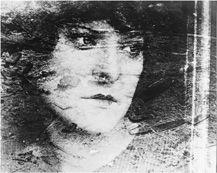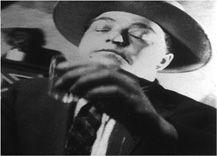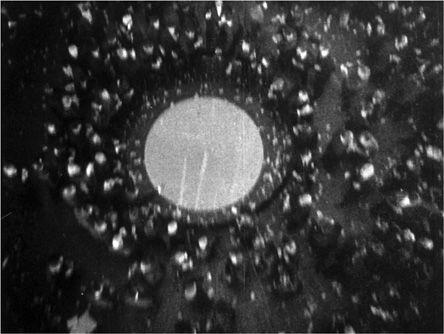B0041VYHGW EBOK (189 page)
Authors: David Bordwell,Kristin Thompson

During the silent era, a number of film movements in France posed major alternatives to classical Hollywood narrative form. Some of these alternatives, such as abstract cinema and Dada filmmaking, are not specifically French and constituted instead a part of the growing international avant-garde. But two alternatives to the American mode remained quite localized. Impressionism was an avant-garde style that operated largely within the film industry. Most of the Impressionist filmmakers started out working for major French companies, and some of their avant-garde works proved financially successful. In the mid-1920s, most formed their own independent companies but remained within the mainstream commercial industry by renting studio facilities and releasing their films through established firms. The other alternative movement, Surrealism, lay largely outside the film industry. Allied with the Surrealist movement in other arts, these filmmakers relied on their own means and private patronage. France in the 1920s offers a striking instance of how different film movements may coexist in the same time and place.
World War I struck a serious blow to the French film industry. Personnel were conscripted, many film studios were shifted to wartime uses, and much export was halted. Yet the two major firms, Pathé Frères and Léon Gaumont, also controlled circuits of theaters. They needed to fill vacant screens, and so in 1915, American films began increasingly to flood into France. Represented by De Mille’s
The Cheat
and films featuring Pearl White, Douglas Fairbanks, Charlie Chaplin, and William S. Hart, the Hollywood cinema dominated the market by the end of 1917. After the war, French filmmaking never fully recovered: In the 1920s, French audiences saw eight times more Hollywood footage than domestic footage. The film industry tried in several ways to recapture the market, mostly through imitation of Hollywood production methods and genres. Artistically, however, the most significant move was the firms’ encouragement of younger French directors: Abel Gance, Louis Delluc, Germaine Dulac, Marcel L’Herbier, and Jean Epstein.
These directors differed from their predecessors. The previous generation had regarded filmmaking as a commercial craft, but the younger filmmakers wrote essays proclaiming cinema to be an art comparable to poetry, painting, and music. Cinema should, they said, be purely itself and should not borrow from the theater or literature. Impressed by the verve and energy of the American cinema, the young theorists compared Chaplin to Nijinsky and the films of Rio Jim to
The Song of Roland.
Cinema should, above all, be (like music) an occasion for the artist to express feelings. Gance, Delluc, Dulac, L’Herbier, Epstein, and other, more tangential members of the movement sought to put this aesthetic into practice as filmmakers.
Between 1918 and 1928, in a series of extraordinary films, the younger directors experimented with cinema in ways that posed an alternative to the dominant Hollywood formal principles. For these directors, cinema was an art of emotion, so the intimate psychological narrative dominated their practice. The interactions of a few characters, usually a love triangle (as in Delluc’s
L’Inondation,
1924; Epstein’s
Coeur fidèle,
1923, and
La Belle nivernaise,
1923; and Gance’s
La Dixième symphonie,
1918), would serve as the basis for the filmmaker’s exploration of fleeting moods and shifting sensations.
“Another period arrived, that of the psychological and impressionist film. It would seem stupid to place a character in a given situation without penetrating into the secret realm of his inner life, and the actor’s performance is explained by the play of thoughts and of visualized sensations.”
— Germaine Dulac, director
As in the Hollywood cinema, psychological causes were paramount, but the school gained the name Impressionist because of its interest in giving narration considerable psychological depth, revealing the play of a character’s consciousness. The interest falls not on external physical behavior but on
inner
action. To a degree unprecedented in international filmmaking, Impressionist films manipulate plot time and subjectivity. To depict memories, flashbacks are common; sometimes the bulk of a film will be one flashback or a series of them. Even more striking is the films’ insistence on registering characters’ dreams, fantasies, and mental states. Dulac’s
The Smiling Mme. Beudet
(1923) consists almost entirely of the main character’s fantasy life, her imaginary escape from a dull marriage. Despite its epiclength (over five hours), Gance’s
La Roue
(1922) rests essentially on the erotic relations among only four people, and the director seeks to trace the development of each character’s feelings in great detail. Impressionism’s emphasis on personal emotion gives the films’ narratives an intensely psychological focus.
The Impressionist movement earned its name as well for its use of film style. The filmmakers experimented with ways of rendering mental states by means of cinematography and editing. In Impressionist films, irises, masks, and superimpositions function as traces of characters’ thoughts and feelings
(
12.23
).
In
La Roue,
the image of Norma is superimposed over the smoke from a locomotive, representing the fantasy of the engine driver, who is in love with her.

12.23 In
Coeur fidèle,
the heroine looks out a window, and a superimposition of the foul jetsam of the waterfront conveys her dejection at working as a barmaid in a dockside tavern.
To intensify the subjectivity, the Impressionists’ cinematography and editing present characters’ perceptual experience, their optical impressions. These films use a great deal of point-of-view cutting, showing a shot of a character looking at something, then a shot of that thing, from an angle and distance replicating the character’s vantage point. When a character in an Impressionist film gets drunk or dizzy, the filmmaker renders that experience through distorted or filtered shots or vertiginous camera movements. In
12.24
, from L’Herbier’s
El Dorado
(1920), a man is drinking in a cabaret.

12.24 In
El Dorado,
a man’s tipsiness is conveyed by means of a curved mirror that stretches his body sideways.
The Impressionists also experimented with pronounced rhythmic editing to suggest the pace of an experience as a character feels it, moment by moment. During scenes of violence or emotional turmoil, the rhythm accelerates—the shots get shorter and shorter, building to a climax, sometimes with shots only a few frames long. In
La Roue,
a train crash is presented in accelerating shots ranging from 13 frames down to 2, and a man’s last thoughts before he falls from a cliff are rendered in a blur of many single-frame shots (the first known use of such rapid editing). In
Coeur fidèle,
lovers at a fair ride in whirling swings, and Epstein presents their giddiness in a series of shots 4 frames, then 2 frames, long. Several Impressionist films use a dance to motivate a markedly accelerated cutting rhythm. More generally, the comparison of cinema to music encouraged the Impressionists to explore rhythmic editing. In such ways, subjective shooting and editing patterns function within Impressionist films to reinforce the narrative treatment of psychological states.
Impressionist form created certain demands on film technology. Gance, the boldest innovator in this respect, used his epic
Napoléon
(1927) as a chance to try new lenses (even a 275mm telephoto), multiple frame images (called Polyvision), and widescreen ratio (the celebrated triptychs; see 5.63). The most influential Impressionist technological innovation was the development of new means of frame mobility. If the camera was to represent a character’s eyes, it should be able to move with the ease of a person. Impressionists strapped their cameras to cars, carousels, and locomotives. For Gance’s
Napoléon,
the camera manufacturer Debrie perfected a handheld model that let the operator move on roller skates. Gance lashed the machine to wheels, cables, pendulums, and bobsleds. In
L’Argent
(1928), L’Herbier sent his camera gliding through huge rooms and even plummeting straight down toward the crowd from the dome of the Paris stock exchange
(
12.25
).

12.25 In
L’Argent,
the camera drops toward the floor of the stock exchange in an effort to convey the traders’s frenzied excitement.
Such innovations had given French filmmakers the hope that their films could win the popularity granted to Hollywood’s product. During the 1920s, the Impressionists operated somewhat independently; they formed their own production companies and leased studio facilities from Pathé and Gaumont in exchange for distribution rights. Some Impressionist films did prove moderately popular with French audiences. But by 1929, most foreign audiences had not taken to Impressionism; its experimentation was attuned to elite tastes. Moreover, although production costs were rising, Impressionists such as Gance and L’Herbier became even more free-spending. As a result, filmmakers’ companies either went out of business or were absorbed by the big firms. Two behemoth productions of the decade,
Napoléon
and
L’Argent,
failed and were reedited by the producers; they were among the last Impressionist films released. With the arrival of the sound film, the French film industry tightened its belt and had no money to risk on experiments.
CONNECT TO THE BLOG
We review the DVD of
La Roue
in “An old-fashioned, sentimental avantgarde film.”
Impressionism as a distinct movement may be said to have ceased by 1929. But the influences of Impressionist form—the psychological narrative, subjective camera work, and editing—were more long-lived. They continued to operate, for example, in the work of Alfred Hitchcock and Maya Deren, in Hollywood montage sequences, and in certain American genres and styles (the horror film, film noir).
Whereas the French Impressionist filmmakers worked within the commercial film industry, the Surrealist filmmakers relied on private patronage and screened their work in small artists’ gatherings. Such isolation is hardly surprising, since Surrealist cinema was a more radical movement, producing films that perplexed and shocked most audiences.
Surrealist cinema was directly linked to Surrealism in literature and painting. According to its spokesperson, André Breton, “Surrealism [was] based on the belief in the superior reality of certain forms of association, heretofore neglected, in the omnipotence of dreams, in the undirected play of thought.” Influenced by Freudian psychology, Surrealist art sought to register the hidden currents of the unconscious, “in the absence of any control exercised by reason, and beyond any aesthetic and moral preoccupation.”